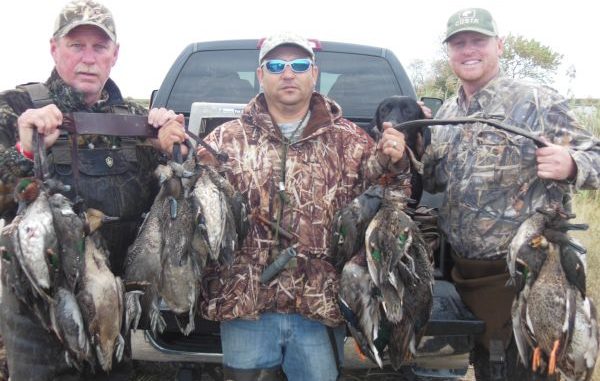
Hunting guide says drought in northern sections of Mississippi Flyway points to great duck hunting.
Operating a boat through a midnight fog Friday night ( Nov. 9) was worth it to reach a remote hunting lease off of Terrebonne Parish’s Lost Lake. With the opening morning came the big ducks and teal that we already knew inhabited the area.
After the weekend of letting the overwhelming teal numbers pass and bagging some early season pintail, my friend Grant Authement and I took a three-hour haul to Hackberry to hunt with Allstar Guide Service’s Jimmy Miller.After two hours of sleep, Miller picked us up from his lodge, and we chatted about the secrets of maintaining land that attracts quality numbers of waterfowl.
“If you can manage your water and salinity levels to get that duck seed and widgeon grass to grow, then you will hold ducks,” Miller said. “I have a culvert that I can turn on and off; last year I realized that keeping it low attracts ducks because it helps them to locate that feed in the mud. It also keeps a south wind from raising the salinity level.”
The conversation progressed into the art form of blind building for maximum coverage, natural impression and ease of use.
“I learned how to build blinds correctly from some old World War II vets at Black Lake Lodge,” Miller said. “A lot of people just use rosseau. I’ll use it just as a base for the blind, but I prefer cutting salt grass and forming it into brooms with electrical tape, then winding it through the thin hog-wire frame supported by 1x3s across the top. After that you can just pull the brooms over for coverage and they won’t collapse. Those specklebellies and mallards will spot you, so you really have to be down in there.”
It was a departure from the approach to which I was accustomed.
“Yea, on our lease, we just put a pallet down and shove bushels of rosseau cane into the ground around it,” I said. “After so many years of doing it, the rosseau just caught, and now there are natural patches of cover growing around many of our blinds now. On the Lost Lake lease, a lot of the brushing process involves actually trimming the rosseau patch that took around it.”
After a two-minute Go-Devil ride, we reached the middle of a large pond and I immediately noticed two things: Miller’s decoy count was in the hundreds, forming a four-leaf-clover pattern around the island of a blind; and there was a brushed boat shed behind the blind that eliminated the need for a pirogue and paddle drive.
“In big, open water you always want more decoys,” Miller explained. “I’m actually about to add another hundred (dekes) to this spread. Something that may seem obvious, but I see people do it often, is keep your decoys close. If possible, you always want to put the blind in the open water and not on a bank because then you open up all directions for birds to light.”
The green-wing tealed immediately started bombarding us, seemingly forgetting the courtesy of allowing us to load up.
“Man, I’ve been guiding hunts for 15 years and I have not seen this many greenwings in my life,” Miller said as we let a lucky group go, knowing that we were just freeing up our bag for big ducks. “Sabine (National Wildlife Refuge, adjacent to Miller’s lease) and Big Lake are holding a lot of grey ducks and pintail, too.”
As the hunt progressed, some of high-flying big ducks didn’t respond to calls. But Miller’s and Authemant’s calling did turn many of the packs of ducks.
“I believe in the mallard call and calling,” Miller said. “Some guys I was hunting with thought that just whistling or not calling as much helps. But sometimes that’s what keeps them interested. Sometimes it’s either they’re going to come in or not.
“If everyone is calling a mixed mallard, widgeon and pintail, in good rhythm and not on top of each other, it works well.”
The hunt went as anticipated, and our 18 bird limit ended up consisting of 60 percent greenwings, with pintail, grey ducks and widgeon filling the rest.
Miller also got a chance to talk to a few specklebelly geese, but to no avail.
“It’s nice to have seasoned hunters with me — the teal were flying hard, and its tough to pass up teal lighting in the decoys,” Miller said. “It’s only going to get better, though, as we get a few more hard cold fronts. The specs and mallards will be down soon enough.”
Miller said he’s looking for the season to be very productive as it unfolds because of conditions farther north in the flyway.
“This is shaping up to be a great season because they just don’t have any food up north due to the drought,” he said. “I’ve heard that the oak trees aren’t even dropping as many acorns because of it.
“So all of the action is in South Louisiana. We have enough feed to hold ducks in the Sabine area. With widgeon grass, duck seed and good water levels, it will be good.”
Read more reports — and post your own photos and reports — in the Waterfowl Hunting Forum. Not a site member yet? It’s free, so click here to get started today!